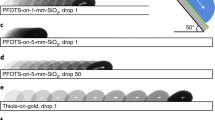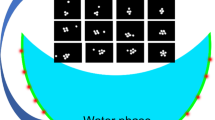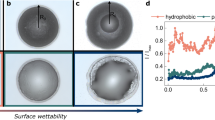Abstract
Electric fields induce motion in many fluid systems, including polymer melts1, surfactant micelles2 and colloidal suspensions3. Likewise, electric fields can be used to move liquid drops4. Electrically induced droplet motion manifests itself in processes as diverse as storm cloud formation5, commercial ink-jet printing6, petroleum and vegetable oil dehydration7, electrospray ionization for use in mass spectrometry8, electrowetting9 and lab-on-a-chip manipulations10. An important issue in practical applications is the tendency for adjacent drops to coalesce, and oppositely charged drops have long been assumed to experience an attractive force that favours their coalescence11,12,13. Here we report the existence of a critical field strength above which oppositely charged drops do not coalesce. We observe that appropriately positioned and oppositely charged drops migrate towards one another in an applied electric field; but whereas the drops coalesce as expected at low field strengths, they are repelled from one another after contact at higher field strengths. Qualitatively, the drops appear to ‘bounce’ off one another. We directly image the transient formation of a meniscus bridge between the bouncing drops, and propose that this temporary bridge is unstable with respect to capillary pressure when it forms in an electric field exceeding a critical strength. The observation of oppositely charged drops bouncing rather than coalescing in strong electric fields should affect our understanding of any process involving charged liquid drops, including de-emulsification, electrospray ionization and atmospheric conduction.
This is a preview of subscription content, access via your institution
Access options
Subscribe to this journal
Receive 51 print issues and online access
$199.00 per year
only $3.90 per issue
Buy this article
- Purchase on Springer Link
- Instant access to full article PDF
Prices may be subject to local taxes which are calculated during checkout




Similar content being viewed by others
References
Schaffer, E., Thurn-Albrecht, T., Russell, T. P. & Steiner, U. Electrically induced structure formation and pattern transfer. Nature 403, 874–877 (2000)
Trau, M. et al. Microscopic patterning of orientated mesoscopic silica through guided growth. Nature 390, 674–676 (1997)
Leunissen, M. E. et al. Ionic colloidal crystals of oppositely charged particles. Nature 437, 235–240 (2005)
Baygents, J. C. & Saville, D. A. Electrophoresis of drops and bubbles. J. Chem. Soc. Farad. Trans. 87, 1883–1898 (1991)
Ochs, H. T. & Czys, R. R. Charge effects on the coalescence of water drops in free-fall. Nature 327, 606–608 (1987)
Calvert, P. Inkjet printing for materials and devices. Chem. Mater. 13, 3299–3305 (2001)
Eow, J. S., Ghadiri, M., Sharif, A. O. & Williams, T. J. Electrostatic enhancement of coalescence of water droplets in oil: a review of the current understanding. Chem. Eng. J. 84, 173–192 (2001)
Fenn, J. B., Mann, M., Meng, C. K., Wong, S. F. & Whitehouse, C. M. Electrospray ionization for mass-spectrometry of large biomolecules. Science 246, 64–71 (1989)
Baret, J. C. & Mugele, F. Electrical discharge in capillary breakup: controlling the charge of a droplet. Phys. Rev. Lett. 96, 016106 (2006)
Link, D. R. et al. Electric control of droplets in microfluidic devices. Angew. Chem. Int. Edn 45, 2556–2560 (2006)
Rayleigh, Lord The influence of electricity on colliding water drops. Proc. R. Soc. Lond. 28, 405–409 (1879)
Sartor, D. A. Laboratory investigation of collision efficiencies, coalescence and electrical charging of simulated cloud droplets. J. Meteorol. 11, 91–103 (1954)
Allan, R. S. & Mason, S. G. Effects of electric fields on coalescence in liquid+liquid systems. Trans. Farad. Soc. 57, 2027–2040 (1961)
Pohl, H. A. Dielectrophoresis (Cambridge Univ. Press, 1978)
Jayaratne, O. W. & Mason, B. J. Coalescence + bouncing of water drops at air/water interface. Proc. R. Soc. Lond. A 280, 545–565 (1964)
Taylor, G. Disintegration of water drops in electric field. Proc. R. Soc. Lond. A 280, 383–397 (1964)
de la Mora, J. F. The fluid dynamics of Taylor cones. Annu. Rev. Fluid Mech. 39, 217–243 (2007)
Mochizuki, T., Mori, Y. H. & Kaji, N. Bouncing motions of liquid-drops between tilted parallel-plate electrodes. Am. Inst. Chem. Eng. J. 36, 1039–1045 (1990)
Hase, M., Watanabe, S. N. & Yoshikawa, K. Rhythmic motion of a droplet under a dc electric field. Phys. Rev. E 74, 046301 (2006)
Jung, Y. M., Oh, H. C. & Kang, I. S. Electrical charging of a conducting water droplet in a dielectric fluid on the electrode surface. J. Colloid Interface Sci. 322, 617–623 (2008)
Allan, R. S. & Mason, S. G. Particle motions in sheared suspensions 14: coalescence of liquid drops in electric and shear fields. J. Colloid Sci. 17, 383–408 (1962)
Bibette, J., Morse, D. C., Witten, T. A. & Weitz, D. A. Stability criteria for emulsions. Phys. Rev. Lett. 69, 2439–2442 (1992)
Binks, B. P. & Lumsdon, S. O. Pickering emulsions stabilized by monodisperse latex particles: effects of particle size. Langmuir 17, 4540–4547 (2001)
Brazier-Smith, P. R. Stability and shape of isolated and pairs of water drops in an electric field. Phys. Fluids 14, 1–6 (1971)
Brazier-Smith, P. R., Jennings, S. G. & Latham, J. Investigation of behavior of drops and drop-pairs subjected to strong electrical forces. Proc. R. Soc. Lond. A 325, 363–376 (1971)
Brazier-Smith, P. R., Latham, J. & Jennings, S. G. Interaction of falling water drops - coalescence. Proc. R. Soc. Lond. A 326, 393–408 (1972)
Sadek, S. E. & Hendrick, C. D. Electrical coalescence of water droplets in low-conductivity oils. Ind. Eng. Chem. Fund. 13, 139–142 (1974)
Urdahl, O., Williams, T. J., Bailey, A. G. & Thew, M. T. Electrostatic destabilization of water-in-oil emulsions under conditions of turbulent flow. Chem. Eng. Res. Des. 74, 158–165 (1996)
Chabert, M., Dorfman, K. D. & Viovy, J. L. Droplet fusion by alternating current (AC) field electrocoalescence in microchannels. Electrophoresis 26, 3706–3715 (2005)
Taylor, S. E. Theory and practice of electrically-enhanced phase separation of water-in-oil emulsions. Chem. Eng. Res. Des. 74, 526–540 (1996)
Acknowledgements
We thank M. Poitzsch and M. Sullivan at the Schlumberger-Doll Research Center for supplying samples of crude oil, C. Holtze, T. Schneider and D. A. Weitz for feedback and the Harvard Nanoscale Science and Engineering Center for support. A.B. acknowledges support from Harvard University's MRSEC.
Author Contributions W.D.R., J.C.B., A.B. and H.A.S. designed the research; W.D.R., J.C.B., A.B. and F.D. performed research; W.D.R., J.C.B., A.B. and H.A.S analysed data; W.D.R. wrote, and all authors commented on, the manuscript.
Author information
Authors and Affiliations
Corresponding author
Supplementary information
Supplementary Information
This file contains Supplementary Discussions, Supplementary Data, Supplementary Figures 1-2 with Legends, Supplementary References and Legends for Supplementary Movies 1-6. (PDF 277 kb)
Supplementary Movie 1
This movie shows immediate coalescence at a low field strength - see file s1 for full Legend. (MPG 2011 kb)
Supplementary Movie 2
This movie shows non-coalescence (bouncing) at a higher field strength - see file s1 for full Legend. (MPG 2964 kb)
Supplementary Movie 3
This movie shows vigorous bouncing at an even higher field strength - see file s1 for full Legend. (MPG 6394 kb)
Supplementary Movie 4
This movie shows two droplets bouncing back and forth in a high field strength - see file s1 for full Legend. (MPG 2240 kb)
Supplementary Movie 5
This movie shows a zoomed-in view of the immediate vicinity at the point of contact for a bouncing drop - see file s1 for full Legend. (MPG 451 kb)
Supplementary Movie 6
This movie shows an example of partial coalescence, where an oppositely charged 'daughter' droplet is emitted from the point of contact - see file s1 for full Legend. (MPG 3315 kb)
Rights and permissions
About this article
Cite this article
Ristenpart, W., Bird, J., Belmonte, A. et al. Non-coalescence of oppositely charged drops. Nature 461, 377–380 (2009). https://doi.org/10.1038/nature08294
Received:
Accepted:
Issue Date:
DOI: https://doi.org/10.1038/nature08294
This article is cited by
-
Modelling droplet size distribution in inline electrostatic coalescers for improved crude oil processing
Scientific Reports (2023)
-
A numerical study of an impacting compound droplet undergoing thermocapillary convection
Acta Mechanica (2022)
-
The role of drop shape in impact and splash
Nature Communications (2021)
-
Effect of gas ionization on interphase interaction of adjacent oppositely charged droplets
Experiments in Fluids (2020)
-
Analysis of Methods for Improving the Efficiency of Coalescence Process in Electric Oil Desalination and Dehydration Plants
Chemical and Petroleum Engineering (2018)
Comments
By submitting a comment you agree to abide by our Terms and Community Guidelines. If you find something abusive or that does not comply with our terms or guidelines please flag it as inappropriate.



